Vivian Thomas Smith loved her apartment. For nearly three decades, she and her husband, Bradley, had lived in a modest one-bedroom at 2420 Morris Avenue, just two blocks from the raucous beauty of the Grand Concourse in the Bronx. The brick apartment complex was a co-op where some families, like theirs, still rented. Vivian, 71, was a retired secretary who had worked for decades at Montefiore Medical Center. Bradley, 81, had also been employed by Montefiore, doing maintenance work before his retirement. Vivian watched her neighbors’ kids grow up. When her own son got sick, her friend down the hall helped nurse him through the long illness that preceded his death. Vivian may have worried about the increasing crime in her neighborhood, but when she walked through her building’s beautifully tiled lobby, she felt secure that she and Bradley would stay there for the rest of their lives.
That all changed in November 2020, when the private equity firm Glacier Equities bought all the rental units in her building. Just over a year later, on December 1, 2021, the Smiths got a letter offering them an ultimatum: buy your apartment or leave when the lease expired on March 31, 2022. “Out of the clear blue sky. No reason, nothing. For 27 years we were never late on rent, never missed a month,” Vivian said.
The couple wanted to buy, but bills from their son’s illness had wrecked their credit. No bank would give them a mortgage. At the same time, their economic situation made finding a new rental almost impossible. Because of the small pensions they received in addition to their Social Security, they made too much money to qualify for subsidized housing. Yet they made nowhere near enough to rent a new apartment.
“We spoke to housing lawyers. The first one said ‘cause our apartment was not rent-stabilized, ‘You don’t have a choice. You have to leave,’” Vivian said.
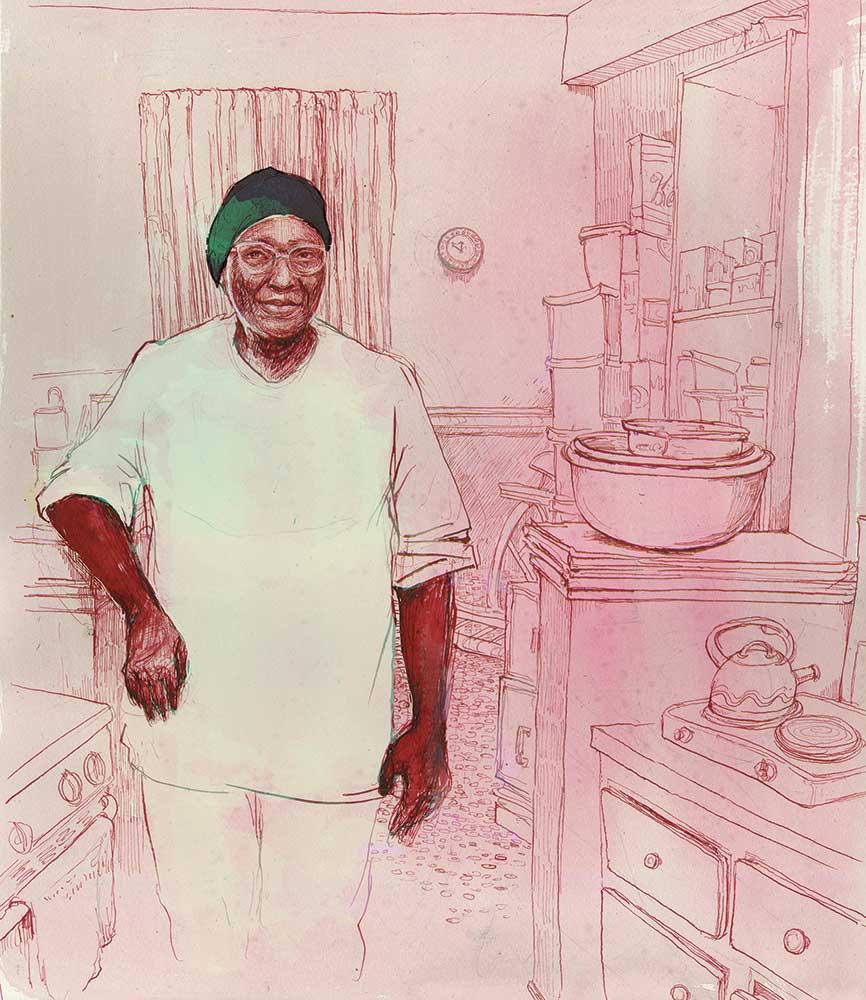
Forced out: Vivian Thomas Smith had lived in her Bronx apartment for 27 years when Glacier Equities suddenly told her she had to leave. Illustration by Molly Crabapple.
Throwing an elderly couple out on the street might be monstrous, but it’s perfectly legal in New York State. If, like the Smiths, you are a tenant in one of the state’s 1.6 million market-rate apartments, your landlord can get rid of you at the end of your lease—no reason necessary—by means of what’s called a holdover eviction. And landlords do it all the time. The more than 32,000 holdover eviction cases brought before New York State housing courts in 2022 represent a small sliver of the problem; unable to afford the stress and financial costs of a legal battle, many tenants just pack up and leave.
A bill that had been making its way through the state Legislature for several years could have been a life raft for the Smiths. Backed by a coalition of housing organizations, the legislation—dubbed the Good Cause Eviction bill—required most landlords to offer lease renewals to tenants like the Smiths, who had paid their rent on time and stuck by the terms of their leases. It also limited rent increases to prevent landlords from forcing people out by raising their rent hundreds of dollars a month.
This bill could have saved the Smiths, and countless other New Yorkers, from eviction. But despite loud, passionate, and relentless campaigning by housing activists and tenants—including Vivian Thomas Smith—lawmakers refused for years to even put Good Cause legislation up for a vote. The Smiths, and all the other tenants like them, were on their own.
The story might have ended there, in defeat. But movements are stubborn creatures. If people fight long enough, they learn that losses are temporary and that victory can only come through a refusal to retreat. Last December, just a month after Democrats held their statewide majority in the midterms, the tenants’ rights group Housing Justice for All renewed its Good Cause campaign and then went even bigger, unveiling “Our Homes, Our Power,” a package of five bills intended to address the worst housing and homelessness crisis in decades. All of the proposals are important, but Good Cause remains the most crucial—not only because it has the power to save people right now, in the present, by slowing the constant stream of evictions, but also because it’s the only one that fundamentally reshapes the relationship between landlord and tenant. Housing activists have until June 8 to persuade state legislators to stand up to the real estate industry and protect their constituents.
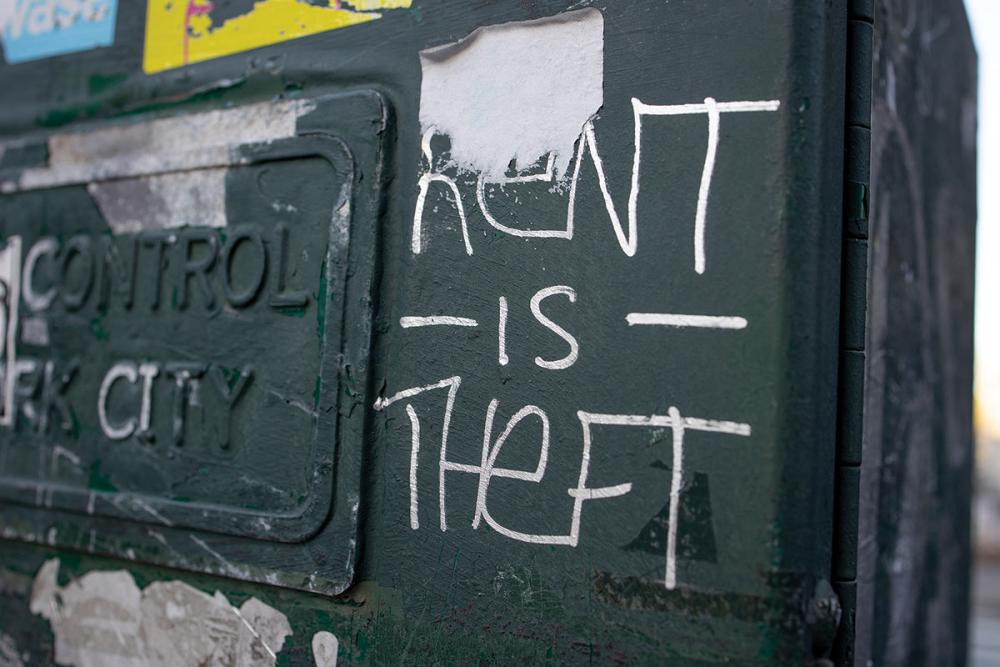
Too damn high: An anonymous correspondent left a stark message about real estate on a traffic light in Brooklyn. (Andrew Lichtenstein / Corbis via Getty Images)
New York City is brutal to renters. As of 2017, half of us spent a third of our income on rent; a third of us spent more than half. The competition for an affordable place is harrowing, with the vacancy rate for apartments that rent for under $1,500 a month hovering at less than 1 percent. Many of us pay nonrefundable application fees just to get our foot in the door, followed by thousands of dollars to the landlord’s broker, and often thousands of dollars more in glorified bribes to the landlords themselves. If we are lucky enough to score a place, it had better be rent-stabilized (a rare prize when landlords are pulling tens of thousands of rent-stabilized units out of circulation every year) if we want to stay. A lease on a market-rate apartment gets us only 12 months of stability. After that, we’re vulnerable to whatever unconscionable rent increases the landlord feels like imposing, or we are back on the apartment hunt—or, for many low-income people, the street—again.
Ideally, this collective precarity should unite people. As Anh-Thu Nguyen, a labor and tenant organizer in Brooklyn, told me, “I don’t care if you’re some bro in the West Village paying $5,000 a month, or a little old lady in Spanish Harlem in a rent-stabilized place for 30 years. You represent a class. That class is the landless…. You want stability, a place you can call home.”
Instead, communities often wind up pitted against each other. One group is forever being forced out, then pushed into areas where another group, often poorer, is being forced out too. This gentrification gets blamed on tenants, even though landlords are the ones raising the rents. When a landlord evicts an abuela and rents her apartment to an NYU grad student, politicians point to gentrifiers or transplants, not the landlord, as the problem. They seldom mention that there was an actual bill that could have kept the abuela in her home.
This is not just theoretical. Good Cause Eviction has long been the law in New Jersey, where cities like Trenton and Jersey City have some of the lowest eviction rates in the country. It also exists in cities like Montreal, as well as in Japan.
Good Cause was first proposed in 2018 by a collection of tenant groups in New York State that was then called the Upstate Downstate Alliance (it eventually became known as Housing Justice for All). In 2019, it found a legislative champion when democratic socialist Julia Salazar came to the state Senate.
The next year, Covid hit, and over 330,000 people fled New York City—mainly from the richest zip codes. Many of them moved upstate in search of a slice of virus-free paradise, driving up rents and home prices in those spots as they went. Back in the city, some landlords panicked in the face of the exodus and offered previously unthinkable rent reductions to entice tenants to stay. Others, especially if they owned rent-stabilized apartments, warehoused their empty units and bided their time.
By April 2020, more than 16 percent of the state’s population was out of work. For hundreds of thousands of tenants, making rent became impossible. If they didn’t pay, what then? Would the courts really send sheriffs to chuck their possessions out onto the sidewalk, then shuttle them to crowded homeless shelters?
A movement erupted to cancel the unpayable rents—led by both established tenant groups and young people radicalized in the uprising that emerged after George Floyd’s murder. Banners were dropped from bridges. Raucous protests were held outside the homes of recalcitrant politicians. It made only a modest impression. While the state and federal governments did act, declaring moratoriums on evictions starting with the CARES Act in March 2020, they wouldn’t cancel rents. Bills still came due each month, and the debts metastasized. Two years later, 595,000 New York City renters were still behind—and landlords were anxious to get them out.
With the arrival of the Covid vaccine, the bars reopened, restaurants buzzed, and the rich flooded back to the city like some revanchist army. For landlords, these returnees were more enticing than those of us who stayed, whether or not we owed back rent.
The federal moratorium expired in October 2021 and the state moratorium in January 2022. Immediately, the evictions began.
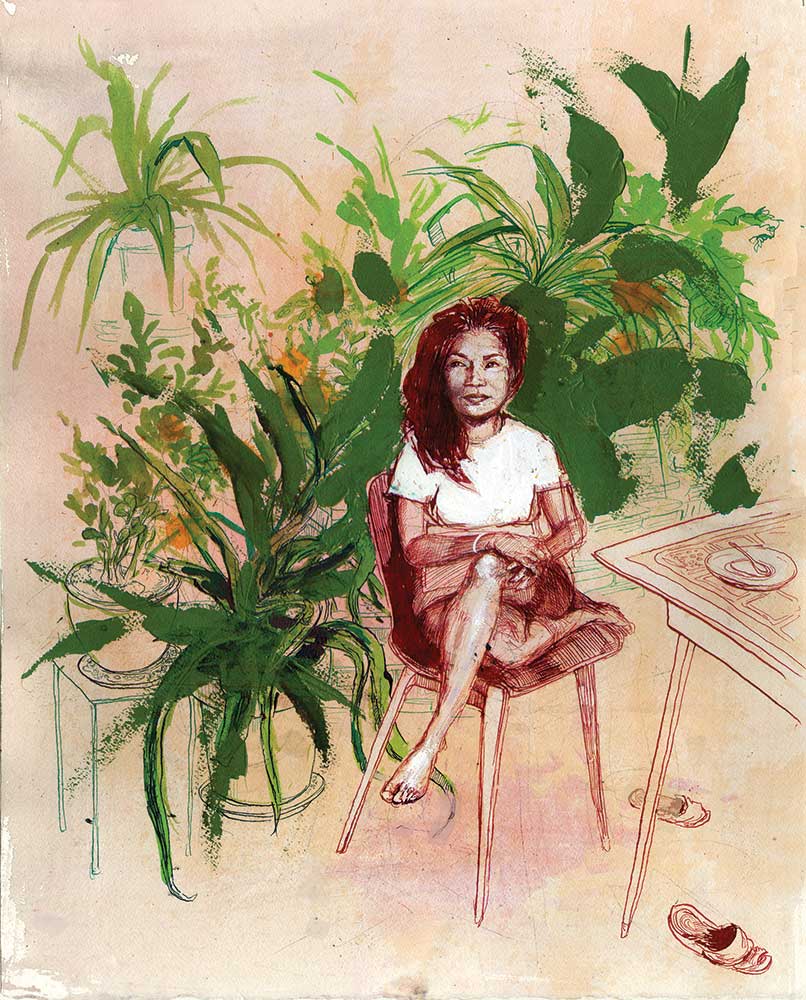
Fighting back: When Anh Thu’s Brooklyn apartment building got taken over by a private equity firm, she helped organize a tenants union and a lawsuit against the company. Every tenant, she says, “wants stability and a home.” (Illustration by Molly Crabapple)
The pandemic was a bonanza for institutional investors in residential real estate. The most famous villain is BlackRock, the multinational investment behemoth, but Glacier Equities has also done a number on New York City. Glacier is a real estate private equity firm, or REPE. A REPE raises cash from private investors to buy a property—say, an apartment building. The REPE then tries to get tenants out, often neglecting the building or hiking rents. Finally, the REPE sells the building, gobbling up the profits for its investors and itself. Over the past two decades, Glacier has flipped—or as it says on its website, “acquired, developed, and sold”—2,200 condos and co-ops in and around New York City. During the first year of the pandemic, it snapped up 255 units in Bronx and Manhattan co-ops. The Smiths’ apartment was one of them.
Glacier’s financing deal required it to evict tenants who could not afford to buy their units, and the company confirmed that it has brought eviction suits against residents in roughly 10 percent of the units in the package of Bronx apartments it bought in 2020. It would not tell me how many others it asked to leave.
Some of Glacier’s tenants were low-income, elderly, or ill, like Joe Conzo, a 9/11 first responder who was fighting cancer. Politicians and activists denounced the private equity firm at rallies. Vivian Thomas Smith attended a half-dozen pickets. She hung a sign supporting the Good Cause Eviction bill on her door, she said, but the building’s management made her take it down. (The management did not return my request for comment.)
When I visited the Smiths in May 2022, Vivian took out a stack of binders in which she had meticulously documented her eviction saga. They told a story familiar to all too many New Yorkers. According to Vivian, after the Smiths were rejected for a mortgage, a representative from the company offered to pay one month of their rent, along with $2,000 for moving expenses and help from a broker. In August 2021, the company issued a notice to the Smiths terminating their month-to-month lease and telling them to vacate by December 31.
A lawyer told the Smiths to keep paying rent. By November, they were advised that they had little chance of staying. Vivian and Bradley decided to stop paying rent, having heard that other people in the building were doing so in hopes of getting a buyout. (Glacier said the Smiths cut off communication at this point.)
In January, Glacier brought a holdover eviction suit against the Smiths. Once the court case began, the Smiths attempted to pay rent, but Glacier refused to accept it. (Glacier said it doesn’t accept rent payments from tenants it’s in active litigation with.) When the court served them papers for a court date in February, the Smiths learned that Glacier was also asking for a money judgment of $3,435. According to Joshua Stephenson, the executive director of West Bronx Housing, who helped the Smiths with their case, this covered the rent from November through January, plus interest.
This wasn’t the only problem. In the spring of 2021, while Vivian was ill with Covid-19 and hooked up to an oxygen tank at home, Glacier had begun a series of renovations on a neighboring apartment, which, Vivian said, filled the Smiths’ home with dust. (Glacier confirmed the construction but denied the dust.) After a gas leak in the building (which was caused by illegal construction, not by Glacier), the gas was turned off in the fall of 2021.
A few months later, in March 2022, workers hired by the building’s management company cut a large hole in the Smiths’ wall. Vermin crawled in at night, Vivian said, keeping her awake.
Despite numerous complaints and a violation issued by the city’s Department of Housing Preservation and Development because of the vermin, the damage wasn’t fixed for months. (Glacier said it doesn’t receive HPD mailings and that the co-op’s management didn’t alert it about the hole until August.)
The stress took its toll on Bradley, who is hard of hearing and walks with difficulty. Vivian eventually took him to the ER. He was having hallucinations. The doctors couldn’t find anything wrong, but she blamed the uncertainty about their future.
In early 2022, Vivian became active in the Good Cause fight, speaking at rallies and giving quotes to the media.
“Good Cause Eviction is important for me because I do not want anyone else to go through an illegal eviction…especially someone our age,” Vivian told me at the time. “You live in a place for 30 years, make it your home, know the people, the neighborhood, and someone just buys the building and says, ‘OK, we want you to leave now, because we want other people to come in.’ How is that fair?”
In a series of lengthy e-mail exchanges and sometimes heated phone conversations, Rachel Brill, an executive at Glacier, confirmed parts of the Smiths’ story, with a more positive spin.
Brill said that the August 2021 eviction notice was a “formality,” and that tenants were assured that “no case would start as long as we were communicating and working towards a solution.”
Brill said that Glacier sued only because the Smiths stopped paying rent and broke off communication. “All they had to do was continue discussions with us, and we would have held off all legal proceedings,” she said. (A holdover eviction suit is not about nonpayment. “They were going to evict whether she paid rent or not,” Stephenson told me.)
Brill disputed other parts of the Smiths’ story. She said Glacier hadn’t evicted “a single tenant,” which is true only if one relies on an extremely narrow definition of the word “evict” and doesn’t count any tenants who gave up and left after a lengthy legal battle and a hopeless verdict. (Glacier has brought more than two dozen eviction cases stemming from the Bronx units it purchased to court.)
Brill also alleged that Smith, an older Black woman with a disabled husband, had chosen to fight for her home of nearly 30 years because, “you have to admit, Miss Smith likes the publicity; she likes the attention.”
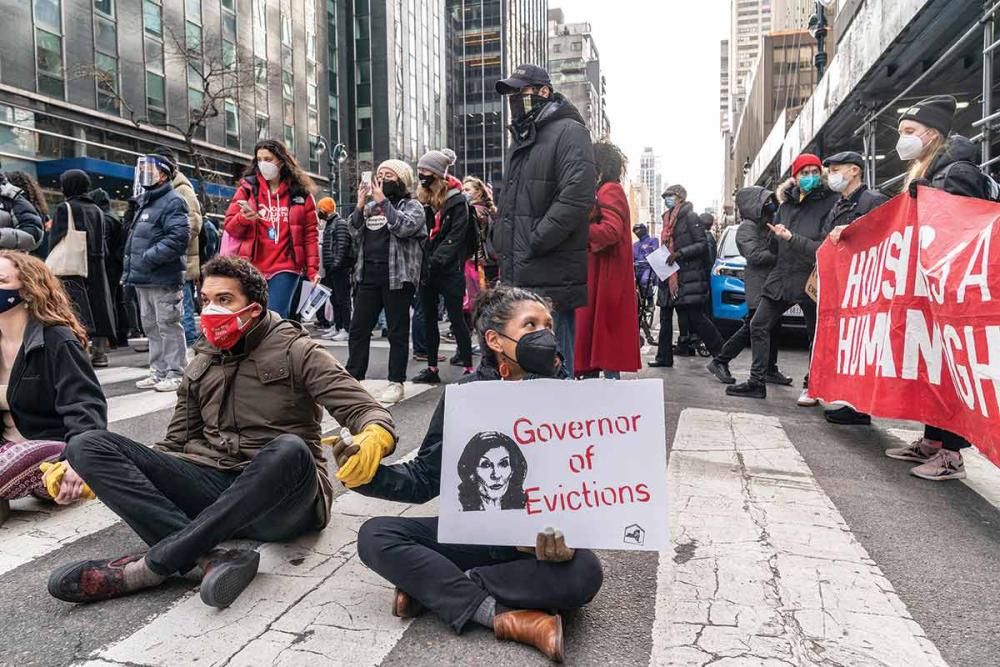
Whatever it takes: Good Cause supporters have blocked roads, flown banners, tangled with police, and relentlessly lobbied politicians. (Lev Radin / Pacific Press / LightRocket via Getty Images)
In early 2022, I was in the midst of my own holdover eviction crisis. My boyfriend and I had lived in a shabby 10-story, nine-unit loft building on Maiden Lane in Manhattan for 12 years. We loved the place with our blood and bones. Our parties were legend. How many times did we meet on our fire escape at 4 am, with cigarettes cadged from war journalists and porn stars? How many canvases—and protest banners—did we paint on our apartment’s battered floors? The heat was dodgy; black mold bloomed on the shower ceiling; rats threw banquets out front. None of this dimmed our enthusiasm. It was home.
The apartment wasn’t rent-stabilized, and during Covid, our landlord let everyone’s lease expire. This didn’t worry us at first, since he had done this before, only to swoop in later with a new contract and a higher rent. Yet I slowly noticed the telltale signs of a landlord preparing to sell his building. They were as obvious as a pigeon starting to molt. The landlord issued furious denials right up until the eviction moratorium ended. After that, we woke up to flyers telling us to cut our rent checks to a new LLC called Diamond Lane. Once those checks were cashed, Diamond Lane hired a process server to serve every tenant with a 90-day notice to vacate. It also threatened lawsuits if we did not comply.
I wasn’t the only long-term tenant. One of my neighbors, for instance, had lived in the building for over two decades. Yet just like Vivian Thomas Smith, in the eyes of the law, we were merely holdover tenants. Our leases had expired. We had no right to stay.
My situation was hardly unique in the spring of 2022. I could no longer keep track of all the people I knew who had gotten a notice to vacate. A filmmaker from Puerto Rico. My friend’s elderly mother, who lived on a fixed income upstate. Another friend who had two well-paid jobs. They came from every income bracket and demographic. All they had in common was that their landlord wanted them out. By March, the median rent in Brooklyn was up 24 percent year-over-year; it was up 29 percent in Manhattan, an all-time high. Landlords smelled blood, and anyone in a market-rate apartment was at risk.
Between mid-January and March, eviction case filings climbed roughly 40 percent, enough to keep the Evicted NYC Twitter bot busy—and too many for the city’s free eviction-prevention lawyers to represent all the low-income tenants fighting eviction in court. Worse, there were almost no units in the city available to rent for less than $1,500 a month. Since most landlords want prospective tenants to earn at least 30 times the monthly rent, $1,500 a month is the highest that someone who makes $45,000 a year can qualify for.
In this atmosphere, the Good Cause campaign took on a desperate urgency. The Housing Justice for All coalition seemed to have a protest every week. In April, tenants marched on the offices of REBNY, New York’s primary real estate lobby group, and then, days later, rallied in Albany. They dropped off hundreds of postcards at the offices of the few New York City politicians who would not endorse Good Cause. They flew banners from windows and hung them off bridges.
On Mother’s Day weekend, I attended a rally held outside Governor Kathy Hochul’s Manhattan office. “She ain’t ever here,” a middle-aged woman told her friends. A few dozen of us stood in the driving rain. We listened to speech after raw speech from a multiracial coalition of mothers who begged Hochul to pass the law that would keep women and children from losing their homes.
On May 17, with just over two weeks to go before the end of the legislative session, I joined Housing Justice for All for a march on Albany. Around 1,000 tenants from across the state gathered at the foot of the Capitol’s steps. Shirley Hawkins was one of them. A 63-year-old volunteer with the Albany housing group United Tenants, Hawkins had organized her neighbors to fight their abusive landlord—all while finishing cancer treatment. “I want to have something for my grandkids, to show them Grandma’s doing it,” she said.
After a fiery rally on the staircase leading to the Capitol, the protesters dispersed toward the Senate and Assembly chambers, whose gold and marble splendor came from an era when America still invested its institutions with beauty. “This is what democracy looks like!” they shouted, a chant I first heard during the Iraq War nearly 20 years earlier.
Fifty or so protesters linked arms in front of the entrances to the Assembly and Senate, keeping everyone from going in or out. Soon enough, the state troopers came with their zip cuffs. On the bus back, I heard that only one protester had gotten roughed up.
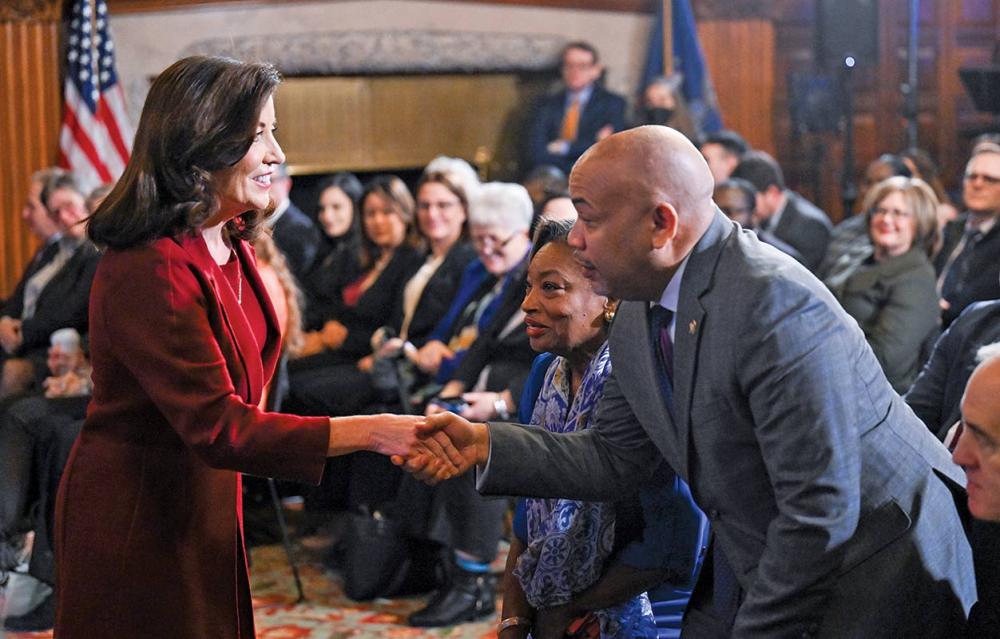
Hand in hand: New York Governor Kathy Hochul and Assembly Speaker Carl Heastie have been two of the most powerful forces blocking Good Cause. (Hans Pennink / AP)
On June 4, 2022, the New York State Legislature closed out its session. Neither the Senate nor the Assembly had brought Good Cause up for a vote. Instead, the Legislature passed a bill setting up a commission to study affordable housing.
After the politicians failed to intervene, landlords brought lawsuits to successfully overturn Good Cause laws in cities like Newburgh and Albany that had passed them in recent years. I thought of Shirley Hawkins, who had seen the statewide law as a potential legacy for her grandchildren.
Good Cause Eviction had tremendous popular support, but it couldn’t compete against the power of the real estate lobby. Trade groups like the Rent Stabilization Association, the Community Housing Improvement Program, and REBNY employed lobbying firms and dumped millions into front groups with wholesome names like Homeowners for an Affordable New York, which presented their members as Mom, Pop, and Grandma, too. (Board members from these trade groups have an average portfolio size in the thousands.)
The groups ran an aggressive ad campaign against Good Cause. They said that “Good Cause Eviction means higher property taxes, fewer quality homes and impossible burdens on property owners.” They warned that the legislation would turn “owning and renting property into a money-losing proposition.” They sent out doom-laden election mailers portraying progressive candidates who might support Good Cause as wild-eyed lunatics who would harm the state.
“The main reason Good Cause Eviction didn’t pass [in 2022] was because Democrats in the state Legislature were paralyzed by the election and afraid of REBNY spending money to defeat them. They decided not to rock the boat,” said Cea Weaver, a key organizer in Housing Justice for All. “They decided inaction and not doing anything was safer for their electoral chances than doing something that could actually activate the base.”
Attack ads were the landlords’ stick, but we also need to talk about the carrot. Landlords spoil their favored politicians as if they were prize piglets competing at the state fair. Sometimes this spoiling gets the law involved. Former lieutenant governor Brian Benjamin was arrested for soliciting bribes from developers (though a judge later dropped the charges), and real-estate-related bribes landed former Assembly speaker Sheldon Silver in jail.
These are extreme cases, but a more polite sort of corruption underpins the entire American system of PACs and lobbyists. Between October 2021 and July 2022, landlord groups poured at least $6 million into Kathy Hochul’s campaign account.
Meanwhile, one of the state’s biggest real estate lobbyists, Patrick Jenkins, is a close friend and former roommate of Assembly Speaker Carl Heastie—one of the state’s three most powerful leaders and, according to Housing Justice for All, one of the major roadblocks to Good Cause passing the Legislature in 2022. Between 2012 and 2019, real estate contributed $1.2 million to the Democratic Assembly Action Committee, through which Heastie distributes campaign funds to other Democratic members. (Heastie’s office didn’t return calls when I asked for comment.)
According to Weaver, ideology is as important as cash in understanding why politicians oppose Good Cause. “It’s a deep, embedded classism where people believe that property owners vote and renters don’t,” she told me.
Politicians, even self-described progressive ones, simply don’t see the renters, who are most of their constituents. One state senator told Weaver that no tenants had contacted his office; the Web forms her group used showed that he had, in fact, received 75 e-mails. “For every one landlord who lobbies an elected official, we have to have 15 tenant constituents tell their story,” Weaver said.
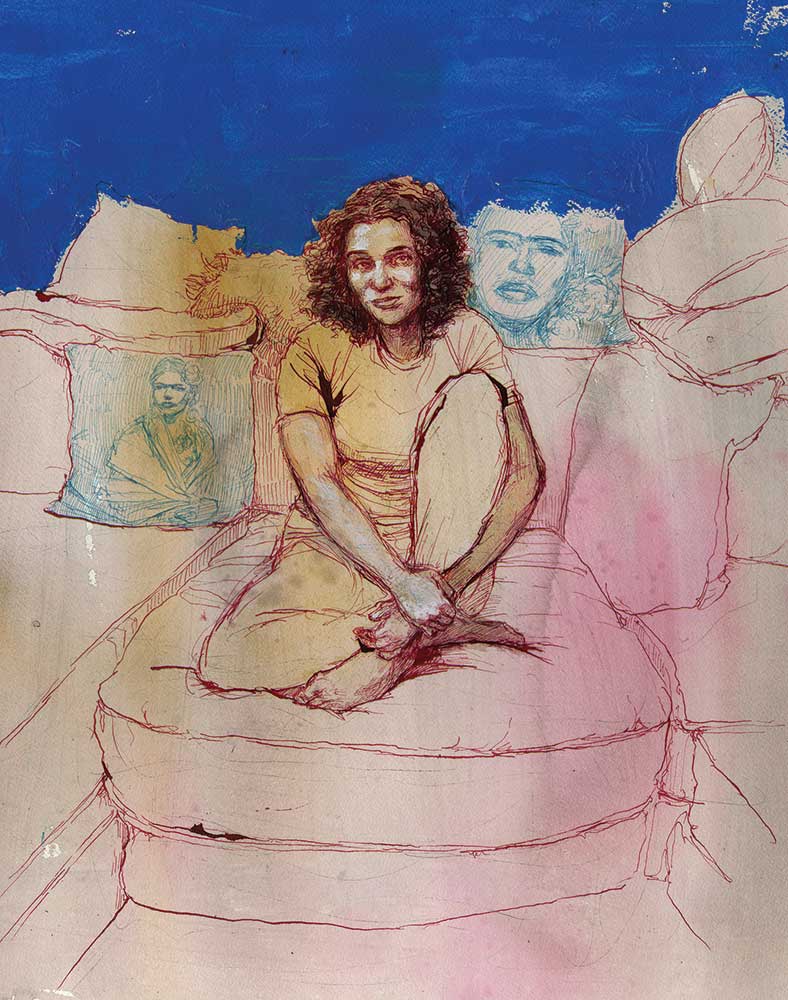
Not going anywhere: Tenant activist Dorca Reynoso is part of the movement pushing to get Good Cause legislation passed. (Illustration by Molly Crabapple)
These politicians offered various excuses for maintaining the status quo. Conservative suburban Democrat James Skoufis called Good Cause “a de facto taking of private property.” In New York City, Assemblywoman Stefani Zinerman, an opponent of Good Cause, invoked the most cynical form of identity politics, citing the need to protect small landlords of color as a justification for policies that hurt Black mothers most of all. When tenants—many of them Black women—protested outside an event where Zinerman was speaking, her staff allegedly called the police. As tenant activist Dorca Reynoso told me, these politicians are “just playing to the people who give them campaign donations and fucking the rest of us.”
Meanwhile, the Smiths had reached their limit. Stephenson of West Bronx Housing helped them get a small buyout that cleared their rental debt, but beyond that, there was nothing more to be done.
When I texted Vivian in October, she was in the hospital. Once she was discharged, she said, she and Bradley would pack up what they could from the last few decades of their lives and head to North Carolina, where her sister owned land. They would live in a trailer on her property. This was not how they imagined they would spend their old age. Their loss is also New York’s loss. A city is nothing without its people.
In November 2022, a few weeks before Housing Justice for All relaunched its Good Cause campaign as part of an even broader housing rights push, I called Cea Weaver. I wanted to know what lessons she took from Good Cause’s defeat. She told me that they hadn’t fought big enough. In 2019, she said, “we were extraordinarily successful because we were leading with this bold, uncompromising vision.” Their tenants’ rights package—minus Good Cause—had passed in defiance of the landlords, with Good Cause as the only part left behind. In 2022, they’d campaigned for Good Cause alone. That had been a mistake.
This is why, she explained, the group is now pushing for Good Cause “alongside rental assistance, expanded social housing, and strengthening tenant power.” She told me about the Tenant Opportunity to Purchase Act, which lets tenants buy their buildings by giving them a right of first refusal for rental buildings that are going up for sale; about reforms to the Rent Guidelines Board, which sets the rents for rent-stabilized apartments in New York City; and about a Housing Access Voucher program that would open up rental assistance to the undocumented and people with felony convictions, among others.
The strategy might be working. Albany is a more leftist place, with half a dozen socialists having followed Salazar into the Legislature, and the overturning of local Good Cause laws has given the campaign for a statewide bill a new urgency. In March, the state Senate put provisions that it said aligned with “the core principles of Good Cause Eviction”into its annual budget resolution. The Assembly’s resolution contained measures that Heastie claimed represented the “essence” of Good Cause, though it didn’t include the words “Good Cause” themselves.
Even if the two chambers hammer out a deal, it still has to get past Hochul. One of the people trying to make sure of that is Genesis Aquino, a Dominican American tenant activist from Sunset Park in Brooklyn, who starred in a video that lit up Twitter over the Martin Luther King Jr. Day weekend. That Sunday, Hochul had come to a Latino church hoping to drum up support for Hector LaSalle, the conservative judge she had nominated to lead the state’s highest court. As Hochul rattled off hollow phrases invoking King’s legacy, Aquino stood up.
“I pray that you listen to tenants, and I pray that you withdraw LaSalle and stand with working-class New Yorkers,” she said. “We need Good Cause Evictions, governor—I pray for you.” Aquino kept speaking even as police escorted her out. As her words reverberated through the church, they served to remind Hochul, and all the other Good Cause opponents, that like the tenants themselves, this fight is here to stay.
Copyright c 2023 The Nation. Reprinted with permission. May not be reprinted without permission. Distributed by PARS International Corp.
Molly Crabapple is an artist and writer for outlets including The New York Times, The New Yorker, Rolling Stone, and The New York Review of Books. She is the author of Drawing Blood and National Book Award–nominated Brothers of the Gun, with Marwan Hisham. Her work is in the permanent collection of the Museum of Modern Art.
The Nation Founded by abolitionists in 1865, The Nation has chronicled the breadth and depth of political and cultural life, from the debut of the telegraph to the rise of Twitter, serving as a critical, independent, and progressive voice in American journalism.
Please support progressive journalism. Get a digital subscription to The Nation for just $24.95!

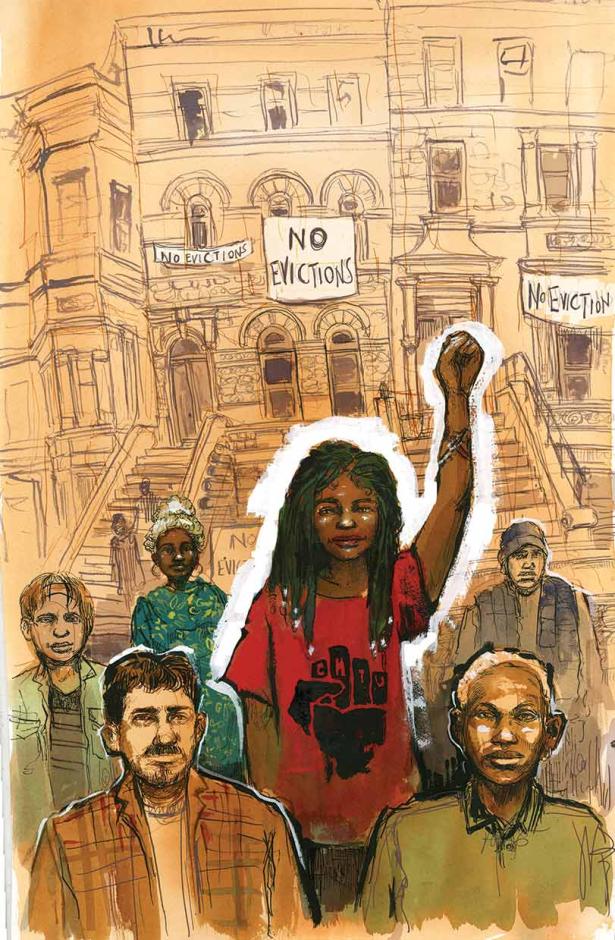
Spread the word